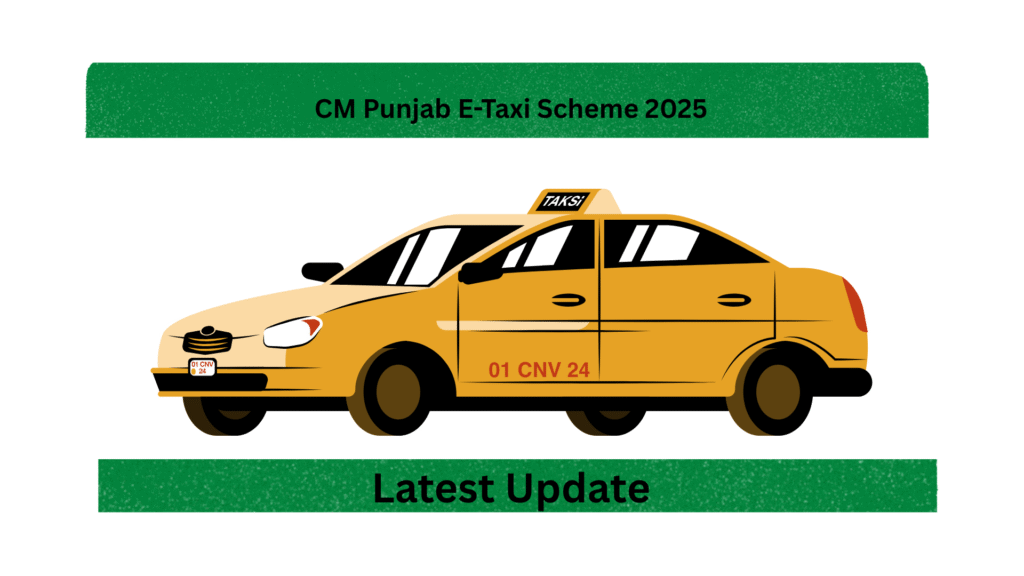
Punjab is taking a big step towards cleaner and smarter urban travel with the launch of its first E-Taxi Scheme. Aimed at reducing pollution and helping drivers boost their earnings, the initiative creates new opportunities for people who want to own and operate electric taxis. Whether you want to switch from a petrol taxi, start your own e-taxi business, or just want to know what the buzz is about, this guide covers everything from eligibility to financial details and more.
Punjab’s First E-Taxi Scheme: What’s Happening and Why
The Punjab E-Taxi Scheme is all about promoting eco-friendly transportation by encouraging the shift from petrol-powered taxis to electric vehicles (EVs). The plan aims to tackle rising carbon emissions and air pollution, especially in urban centers like Lahore. Backed by the provincial government, the scheme is the result of collaborative efforts by the transport ministry and government agencies. Approvals have been received, and the program is entering its official launch phase.
Key decisions have already been made, including the types of vehicles that will be available and the financing terms. The scheme is designed to be accessible, offering a mix of government subsidies, bank financing, and easy-to-meet requirements. Soon, a dedicated online portal—built by the Punjab Information Technology Board (PITB)—will open for registrations. This portal will streamline the application process, making it simple for interested drivers and companies to apply.
Notably, the program covers both individual applicants and existing taxi operators. By making green travel both practical and affordable, Punjab hopes to set a new standard for sustainable city transport.
Who Can Apply? E-Taxi Scheme Eligibility Explained
The scheme is open and accessible, with straightforward terms that put the opportunity within reach for many. To qualify, you’ll need to meet a few basic requirements:
Eligibility criteria:
- You must have a digital driving license.
- Your credit record must be clean—no bank defaults.
For existing taxi companies:
- There are dedicated quotas and potential subsidies depending on the number of vehicles you operate.
- Companies can apply for multiple taxis, with certain slabs set for subsidy based on their fleet size.
Since the e-taxi itself is considered an earning asset, banks do not require complex guarantees. This removes one of the main hurdles for everyday drivers and small operators planning to enter the market.
The scheme is open to:
- Individuals interested in starting or growing a taxi business.
- Existing drivers running taxis on platforms such as Uber, Careem, InDrive, or other services.
- Taxi companies wishing to upgrade or expand their fleets.
Registration and Application Process: How to Get Started
Registration hasn’t begun just yet, but the process is expected to begin shortly after the online portal goes live. The PITB is developing the registration system, making it possible to apply from anywhere with internet access.
Here’s what to expect:
- The online portal will launch within days.
- The Chief Minister and Maryam Nawaz will officially inaugurate the scheme.
- Applications will open soon after the inauguration.
- Registration will be on a first-come, first-served basis with only 1,100 e-taxis up for grabs in the first phase.
The application process will be simple and won’t involve lengthy checks or paperwork beyond the core eligibility rules. The quick and digital process means there’s no need for special recommendations or connections; just meet the criteria and submit your application.
What Kind of E-Taxi Will You Get? Specs and Features
Punjab’s E-Taxi Scheme isn’t just putting any car on the road. The vehicles in the scheme meet strict requirements to ensure reliability, efficiency, and a smooth driving experience.
Key vehicle specs:
| Feature | E-Taxi Scheme Vehicle | Typical Petrol Taxi |
|---|---|---|
| Minimum Range | 300 km per charge | 250-400 km per tank |
| Battery Warranty | 6 years | Not applicable |
| Motor Warranty | 6 years | Not applicable |
| Maintenance | Minimal (no oil/water changes) | Regular engine/oil service |
| Branding | Dedicated taxi design, not personal car | None or taxi sign |
Battery and motor are the only major moving parts. No oil or water changes are required, bringing maintenance costs and hassles down.
Branding and Use Restrictions:
- Vehicles are specially branded for use as e-taxis.
- The scheme’s goal is to keep cars in the public transport system, so you can’t use them as personal vehicles while on the scheme.
- Dedicated design, wraps, and visible signs reinforce the environmental focus and governmental support for cleaner streets.
For the duration of the lease/financing period, government oversight ensures the taxis remain in service. This helps prevent the drift into personal use, which has been a challenge with past schemes. After repayment is complete, owners are free to repaint or convert the vehicle as they like.
Down Payment, Loan, and Monthly Installments: The Financial Details
Money is often the biggest challenge facing new taxi owners—but Punjab’s E-Taxi Scheme takes steps to make ownership easy and affordable.
- Vehicle Cost (Financing Available): Approx. 6.5 million PKR (65 lakhs)
- Down Payment: 30% of total cost, around 1.8 to 2 million PKR (18 to 20 lakhs)
- Government Subsidy: The Punjab government may cover 25-30% of the down payment, reducing your upfront cost. Final subsidy details will be shared upon launch.
- Bank Loan: The remaining balance will be financed through a bank loan.
- Government will pay the interest on your behalf for the loan term.
- Monthly Installment: Estimated at just 600 PKR
Quick financial breakdown:
- Calculate your 30% down payment on a 6.5 million PKR vehicle: around 1.95 million PKR.
- Apply the government subsidy (let’s say 30%): Your own payment could drop to just 800,000 to 1,000,000 PKR.
- Bank pays remaining amount, with the government taking care of all interest.
- You pay an affordable monthly installment—making ownership possible for many more drivers.
For taxi companies:
- Quotas and additional subsidy support are available for larger orders, helping businesses update fleets without financial strain.
Frequently Asked Questions (FAQ) About Payments
Q: Can I get a taxi with less than 30% down payment?
A: If the subsidy covers 30% of the cost, your out-of-pocket will reduce dramatically, but check for the final government decision at launch.
Q: What if I don’t want to use a specific app or platform?
A: You’re free to drive on any ride-hailing service (Uber, Careem, etc.), not just government networks.
Q: How soon do I need to pay?
A: Payment deadlines and installment schedules will be shared on the portal after it goes live.
How E-Taxis Boost Driver Earnings and Business
Switching to an electric taxi isn’t just good for the environment—it’s good for your wallet. With lower running costs and fewer breakdowns, drivers can almost double their earnings compared to conventional petrol taxis.
Pros of E-Taxis for Drivers:
- Higher income: Lower fuel costs and less spent on repairs means more profit.
- Affordable ownership: Subsidy and government-paid interest keep financial barriers low.
- Reliable performance: Six-year warranties on battery and motor reduce worries.
- Flexible operations: You can operate on any network—Careem, Uber, InDrive, and more.
- Family support: A stable, government-backed business model gives your family steady income.
By helping drivers move from petrol to electric, the scheme opens up a low-risk, high-reward path for anyone serious about the taxi business.
Lessons from the Past: What’s Different This Time?
Previous taxi schemes in Punjab had mixed results. For example, the “Yellow Cab” project from over a decade ago eventually saw many vehicles converted for personal use. Today’s E-Taxi Scheme takes a new approach.
Key differences:
- Vehicles are strictly leased, and the government keeps tabs on their use throughout the finance period.
- Branding and dedicated wraps help identify taxis in service.
- After financing is finished, drivers can repaint or repurpose as they wish, but only after fulfilling the full lease.
Q&A: Ensuring E-Taxis Stay in Service
Q: How will the government make sure taxis aren’t used as private cars during the lease?
A: Vehicles will carry official branding during the entire lease period and their use will be monitored.
Q: Can I repaint or convert the taxi after the lease ends?
A: Yes, after repaying the full amount, the taxi is yours to use as you like.
Q: Am I locked into using a government app?
A: No, you can work with any ride-hailing platform.
New Developments: Lahore’s Upcoming Tram & the Bigger Transport Picture
Beyond e-taxis, Punjab’s government is bringing more modern, green solutions to public transport. A big project in the works is the launch of a tram system in Lahore, offering a new way to get around the city without those daily emissions headaches.
The Transport Minister’s efforts support a shift from old, polluting transport models to new, clean, electric ones. The E-Taxi Scheme is just one part of a wider push to make public transportation more convenient, reliable, and friendly to the environment.
Stay Informed: Get the Latest Updates
Keep visiting our site for latest updates about Punjab Govt Schemes
Final Thoughts
Punjab’s E-Taxi Scheme is a bold step towards a cleaner and more profitable future in transportation. By offering affordable, reliable e-taxis through a simple, transparent process, the government is making it possible for more drivers to go green and boost their income.
If you dream of running your own taxi with less hassle, fewer breakdowns, and more money left at the end of the month, this scheme is for you. Stay ready for the official application launch, check the latest updates, and take your chance to drive Punjab into a cleaner tomorrow.
